The church of Santa Maria del Popolo is renowned for its Renaissance interior, created by some of the most talented artists of the fifteenth and sixteenth centuries. A chapel was built here as early as in 1099.
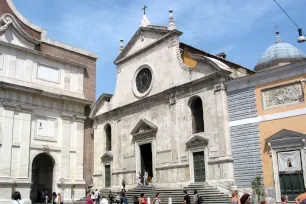
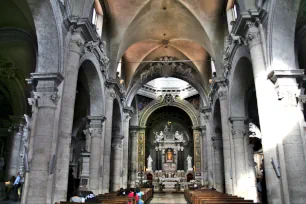
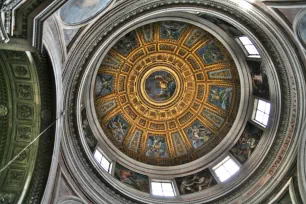
The church is situated at Piazza del Popolo, right near the Porta del Popolo, a monumental sixteenth-century gate which marked the border of the city.
Nero’s Ghost
Santa Maria del Popolo occupies a spot which was thought to be emperor Nero’s burial place. During the Middle Ages, people were convinced that the ghost of Nero – who had a horrible reputation, in part due to his persecution of Christians – haunted a walnut tree that grew here.
In 1099 people of Rome demanded Pope Paschal II to exorcise the area and the pope duly obliged. It is said he chopped down the tree himself – Mary allegedly appeared to him in a vision and ordered him to do so. The pope then had the ground excavated and the human remains that were found were burned and thrown in the river. A chapel was built at the site to chase Nero’s ghost away. Its construction also celebrated the capture of Jerusalem by the Crusaders that same year.
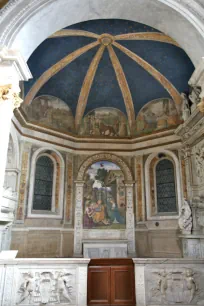
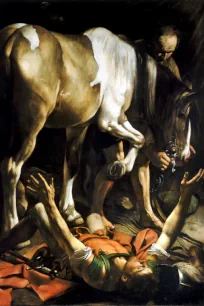
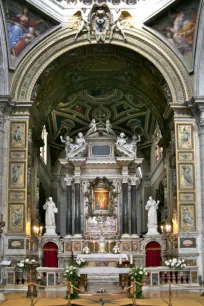
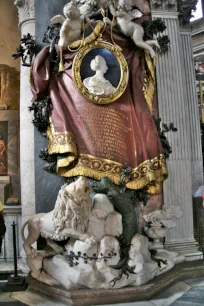
Church and Monastery
In the thirteenth century, a small church was built at the site of the eleventh-century chapel. The church we see today dates from 1472-1477 and was constructed during the reign of Pope Sixtus IV by the Florentine architect Baccio Pontelli. In 1505 Donato Bramante expanded the apse. Gian Lorenzo Bernini later added Baroque elements to the main facade.
Adjacent to the church stood the monastery of Santa Maria del Popolo, the first Augustinian monastery in Rome. During his visit to Rome in 1510-1511, Martin Luther, an Augustinian monk who would later become a leading figure of the Reformation, stayed here. The monastery was destroyed in 1527 during the sack of Rome.
Its Name
There are several theories about the church’s name. One theory is that the original chapel built here was financed with money donated by the people of Rome (popolo is Italian for people). Another theory is that the church received its name because it was built as a parish church for the people in the neighborhood. Others claim that the name is derived from the poplars that grew here during Antiquity; the Latin word for poplar is populus, which coincidentally also means people.
Design
Santa Maria del Popolo has a traditional layout in the shape of a Latin cross, with a main nave and two side aisles bordered by richly decorated chapels. The church boasts three domes: two of its side chapels – the Cybo Chapel and the Chigi Chapel – have their own dome, and a large central dome rises high above the main nave. The central dome is decorated with a ceiling painting of the Virgin in Glory, by Rafaele Vanni.
Interior
The church of Santa Maria del Popolo was one of the first in Rome that was decorated in the new Renaissance style, and the abundance of precious paintings and sculpture inside makes it a treasure trove for art lovers.
One of the highlights is the Capella della Rovere, the first chapel on the right. It is decorated with frescoes painted in 1490 by Pinturicchio. The altar painting of the Birth of Jesus is also by his hand.
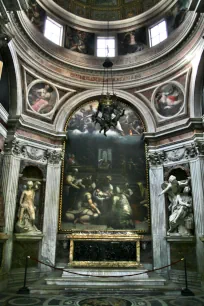
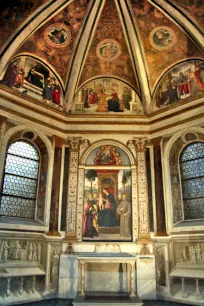
The next chapel is the Capella Cybo, originally created in the late fifteenth century by Pinturiccio for cardinal Innocenzo Cybo but later, in 1681-86, redesigned by Carlo Fontana for another Cybo cardinal, Alderano Cybo.
Opposite the Cybo Chapel is the Capella Chigi. This chapel was designed by Raphael for his patron, the Sienese banker Agostini Chigi. The altarpiece was created by Sebastiano del Piombo. There are four marble statues of prophets in the chapel. Jonah and Elijah were sculpted by Lorenzetto; the other two, Daniel and Habakkuk, are the work of Bernini. Raphael himself designed the pyramid-shaped tombs; he was probably inspired by the Pyramid of Caius Cestius. Nearby is the impressive tomb of Maria Flaminia Odescalchi Chigi, designed in the late eighteenth century by Paolo Posi.
The most famous masterpieces can be found in the Capella Cerasi, the chapel left of the altar. The two paintings of Caravaggio, ‘The Conversion of St. Paul’ and ‘The Crucifixion of St. Peter’ are the star attractions here. They were created in 1601-1602 in a – for its time – unusually realistic style, with dramatic use of lighting. They contrast starkly with Annibale Carracci’s central painting, which shows idealized, evenly lighted figures.
In the apse are two unique stained-glass windows – the oldest in Rome – created in 1509 by the French artist Guillaume de Marcillat. The icon of Mary over the main altar is known as the Madonna del Popolo. It was long thought to be one of seven paintings created by Luke the Evangelist, but the image in fact was created by a Sienese painter in the thirteenth century.

